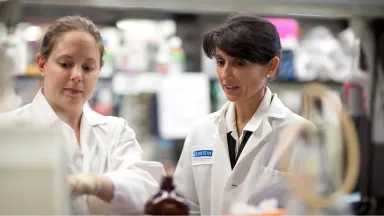
Ganjam V. Kalpana, Ph.D.
- Professor, Department of Genetics
- Professor, Department of Microbiology & Immunology
- Mark Trauner Faculty Scholar in Neuro-oncology
Area of research
- To understand the role of INI1/hSNF5/SMARCB1, a component of the SWI/SNF complex and a tumor suppressor, in HIV-1 replication and human Cancers using cell culture and mouse models, and to develop novel therapeutic strategies.
Phone
Location
- Albert Einstein College of Medicine Jack and Pearl Resnick Campus 1300 Morris Park Avenue Ullmann Building 821 Bronx, NY 10461
Research Profiles
Professional Interests
Molecular Genetic Analysis of INI1/hSNF5 in HIV-1 Replication, HIV-1 latency and Cancer: Single molecule analysis to Organismal studies
INI1/hSNF5/SMARCB1/BAF47 is a component of the chromatin remodeling SWI/SNF complex. This complex influence replication of HIV-1 and SARS Corona Virus-2. INI1/SMARCB1 was discovered as a HIV-1 IN binding protein and is a tumor suppressor biallelically mutated/deleted in many human cancers. The goal of our laboratory is to determine how INI1 affects viral replication, tumor suppression, and in general cellular function.
(i) RNA mimicry of IN-binding Rpt1 domain and novel strategies to inhibit acutely and latently infected HIV-1: Viruses coopt many cellular factors for its own replication. INI1/SMARCB1 is one such factors that is hijacked by HIV-1 to facilitate its replication. INI1/SMARCB1 plays multiple roles during HIV-1 replication including viral integration, transcription and post-transcriptional events. Interfering with IN and INI1 interaction leads to potent inhibitory effects. NMR structure of IN-binding Rpt1 domain of INI1 revealed that it structurally mimics TAR RNA and that this is important for IN binding and to facilitate particle production. Currently we are developing novel class of anti-HIV therapeutics by leveraging the structure of INI1 and its molecular mimicry to TAR RNA. Initial studies demonstrate that these novel therapeutics are able to inhibit both acute and latent HIV-1 replication. The goal is to complete these studies and then trasnlate it into clinic.
(ii) RNA binding by INI1/SMARCB1 and its implications for viral and cellular transcription: We have identified a novel function of INI1, namely its ability to bind to HIV-1 TAR RNA and cellular 7SK RNA. Interestingly, TAR and 7SK mimic each other. TAR RNA binds to HIV-1 tat protein and is required for transcriptional elongation. 7SK is a cellular long non-coding RNA (lnc) and has implications for enhancer-mediated functions during transcription. This novel function is likely to shed light on SMARCB1 role in transcription, tumor suppression.
(iii) Study of HIV-1 latency- Application of a novel single cell and single molecule RNA-FISH and IF method: A final hurdle to eradicate HIV-1 is the persistence of the virus in latent reservoirs, which are transcriptionally suppressed and low in number. While the current drugs control viremia, they are unable to eliminate the virus from the infected cells. To detect these rare reactivated latent cells in patient samples, we have developed novel Single Cell Single Molecule Immuno-fluorescence and RNA-FISH assay (SMIRA) in collaboration with Dr. Robert Singer. This novel assay will be applied to characterize latent reservoirs in various anatomical locations and the effect of various Latency Reversing Agents (LRA, that are in clinical trials) and drugs of abuse.
(iv) Mechanism of tumor suppression by INI1/hSNF5 and developing novel and effective therapeutic strategies to combat INI1-deficient tumors: By using a series of genetic systems developed in our laboratory (knock-out, knock-in mouse models, cell culture models), we are dissecting the mechanism of INI1-medaited tumor suppression and developing molecularly targeted therapies. Previously we discovered that INI1 harbors a masked nuclear export signal. Recently, in collaboration with international team of neuropathologists, we have found that mutations that affect the regulated nuclear export is a tumorigenic event that it offers a novel therapeutic target. In addition, we are investigating novel downstream targets of INI1/SMARCB1 and their effect on senescence and their therapeutic potential.
Selected Publications
Dixit U, Bhutoria S, Wu X, Qiu L, Spira M, Mathew S, Harris R, Adams LJ, Cahill S, Pathak R, Rajesh Kumar P, Nguyen M, Acharya SA, Brenowitz M, Almo SC, Zou X, Steven AC, Cowburn D, Girvin M, Kalpana GV. INI1/SMARCB1 Rpt1 domain mimics TAR RNA in binding to integrase to facilitate HIV-1 replication. Nat Commun. 2021 May 12;12(1):2743. doi: 10.1038/s41467-021-22733-9. PMID: 33980829. (Highlighted in Einstein Research Brief https://einsteinmed.edu/research-briefs/2601/a-novel-strategy-for-inhibiting-hiv-1-replication/
Pathak R, Zin F, Thomas C, Bens S, Gayden T, Karamchandani J, Dudley RW, Nemes K, Johann PD, Oyen F, Kordes U, Jabado N, Siebert R, Paulus W, Kool M, Frühwald MC, Albrecht S, Kalpana GV*, Hasselblatt M*. Inhibition of nuclear export restores nuclear localization and residual tumor suppressor function of truncated SMARCB1/INI1 protein in a molecular subset of atypical teratoid/rhabdoid tumors. Acta Neuropathol. 2021 Aug;142(2):361-374. doi: 10.1007/s00401-021-02328-w. Epub 2021 May 18. PMID: 34003336; PMCID: PMC8270878. *equal correspondence. (Highlighted in Einstein Research Brief
https://www.einsteinmed.edu/research-briefs/2626/change-in-proteins-location-may-cause-aggressive-cancers/
David A., Rao V. R., Wu, W., Ramasamy, S., Pujato, M., Ruiz, A. P., Fiser, A., Bresnick, A., Kalpana,G. V., Prasad, V. R. (2019) CCL2 Mobilizes ALIX to Facilitate 1 Gag-p6 Mediated HIV-1 Virion Release. eLife;8:e35546
La Porte, A., Cano, J., Wu, X., Mitra, D., Kalpana, G. V. (2016) An essential role of INI1/hSNF5 chromatin remodeling protein in HIV-1 post-transcriptional events and Gag/GagPol stability. J Virol. 2016 Oct 14;90(21):9889-9904 (PMID:27558426 PMCID:PMC5068538)
Bhutoria, S., Kalpana G. V.*, and Acharya, S.* (2016) Computational Modeling of Repeat1 region of INI1/hSNF5: An evolutionary link with Ubiquitin. *Equal corresponding authors. Protein Sci. (PMID:27261671)
Mathew, S., Nguyen, M., Wu, X., Pal, A., Shah, V. B., Aiken, C., and Kalpana, G. V. (2013) INI1/hSNF5-interaction defective HIV-1 IN mutants exhibit impaired particle morphology, reverse transcription and integration in vivo. Retrovirology. 10:66. [Epub ahead of print] PMID:2379988
Smith, ME, Cimica V, Chinni S, Jana S, Koba W, Yang Z, Fine E, Zagzag D, Montagna C, Kalpana GV. (2011). Therapeutically targeting Cyclin D1 in primary tumors arising from loss of Ini1. Proc Natl Acad Sci U S A. 108:319-24. Epub 2010 Dec 20. PMID: 21173237





